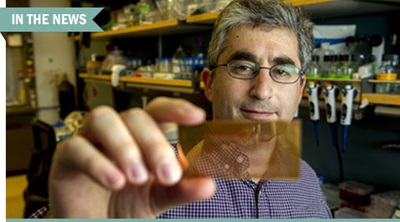 Photo Credit: Norbert von der Groeben/Stanford School of Medicine
Photo Credit: Norbert von der Groeben/Stanford School of Medicine
If a new microchip test wins approval from the Food and Drug Administration (FDA), there could soon be a new, simple, and cheap way to test for type 1 diabetes. Recently, Stanford University researchers successfully used a small, inexpensive microchip to diagnose the disease. The new test involves a plasmonic gold chip used for near-infrared fluorescence-enhanced (NIR-FE) detection of islet cell-targeting autoantibodies.
The test arrives amid the changing demographics of diabetes, as well as an evolving understanding of the natural history of type 1 diabetes. The incidence of both type 1 and type 2 diabetes is on the rise. Type 1 diabetes was once thought to exclusively develop in childhood, but today, about one-quarter of affected individuals are diagnosed with the disease as adults. Conversely, children now are being diagnosed with type 2 diabetes, something that occurred quite rarely in the past. At the same time, emerging but promising research also shows that immune-modulating and antigen-specific therapies could fundamentally alter the progression of type 1 diabetes.
These trends place a premium on early, accurate, and rapid detection of the tell-tale autoantibodies associated with type 1 diabetes—insulin, glutamic acid decarboxylase, and/or tyrosine phosphatase islet antigen 2. Yet existing methods like enzyme-linked immunosorbent assays and lateral flow assays “underperform when applied to [type 1 diabetes] diagnostics, failing to meet the necessary sensitivity and specificity demands of this clinical situation,” according to the authors. While the de facto standard radioimmunoassays have higher sensitivity than other methods, they remain “time and labor intensive and … unable to provide results before a physician needs to initiate therapy, thus limiting the therapeutic options available to the patient,” wrote the investigators.
“With the new test, not only do we anticipate being able to diagnose diabetes more efficiently and more broadly, we will also understand diabetes better—both the natural history and how new therapies impact the body,” said Brian Feldman, MD, PhD, senior author of the newly published research, in a prepared statement.
The NIR-FE test requires as little as 2 µL of whole blood obtained from a finger prick, takes just minutes to produce results, doesn’t rely on radioactive materials, and does not require extensive training to use. The researchers validated the test in 39 patients with new-onset diabetes, 26 of whom were later diagnosed with type 1 diabetes and 13 with type 2 diabetes. The validation also included five nondiabetic controls. The authors also compared NIR-FE against radioimmunoassay and found that they yielded similar sensitivity (100%) and specificity (85%) in distinguishing type 1 diabetes.
“Using recent advances in plasmonic gold substrate for NIR-FE detection, we developed a platform that overcomes the major challenges to rapid, sensitive and specific diagnosis of diabetes,” the authors explained. Each of the new chips is expected to cost about $20 apiece, and each can be used for up to 15 separate tests.
In published media reports, Feldman indicated that the researchers intend to seek FDA approval for the test. Should this occur, the NIR-FE test could improve care and inform diabetes treatment in several ways, according to the authors. “For example, serial monitoring of autoantibodies in patients undergoing new interventions might predict efficacy, as therapies that protect against continued islet cell destruction may correlate with a decline in autoantibody titer,” they wrote. “Furthermore, following antibody levels at high resolution in patients considered high risk would yield great insight into the natural history of the development of diabetes.”